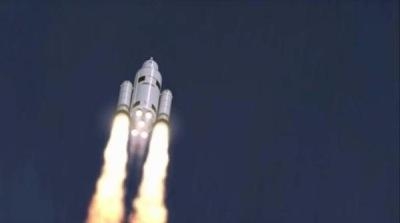Fri, Jul 04, 2014
Agreement Reached As Core-Stage Critical Design Review Closes
NASA has finalized a contract with Boeing to develop the core stage of the Space Launch System (SLS), the most powerful rocket ever built and destined to propel America’s return to human exploration of deep space.

The $2.8 billion contract validates Boeing’s earlier selection as the prime contractor on the SLS core stage, including the avionics, under an undefinitized contract authorization. In addition, Boeing has been tasked to study the SLS Exploration Upper Stage, which will further expand mission range and payload capabilities.
The agreement comes as NASA and the Boeing team complete the Critical Design Review (CDR) on the core stage – the last major review before full production begins.
"Our teams have dedicated themselves to ensuring that the SLS – the largest ever -- will be built safely, affordably and on time,” said Virginia Barnes, Boeing SLS vice president and program manager. “We are passionate about NASA’s mission to explore deep space. It’s a very personal mission, as well as a national mandate.”
During the CDR, which began June 2, experts examined and confirmed the final design of the rocket’s cryogenic stages that will hold liquefied hydrogen and oxygen. This milestone marks NASA’s first CDR on a deep-space human exploration launch vehicle since 1961, when the Saturn V rocket underwent a similar design review as the United States sought to land an astronaut on the moon. Boeing participated in that CDR as well, as the three stages of the Saturn V were built by Boeing and its heritage companies Douglas Aircraft and North American Aviation.
Scheduled for its initial test flight in 2017, the SLS is designed to be flexible and evolvable to meet a variety of crew and cargo mission needs. The initial flight-test configuration will provide a 77-ton capacity, and the final evolved two-stage configuration will provide a lift capability of more than 143 tons.
(NASA artist's concept of SLS launch from file)
More News
From 2021: The Inside Skinny On What Being An ANN Oshkosh Stringer Is All About By ANN Senior Stringer Extraordinare, Gene Yarbrough The annual gathering at Oshkosh is a right of p>[...]
Video Showed That During The Takeoff, The Nose Baggage Door Was Open On May 10, 2025, about 0935 eastern daylight time, a Piper PA-32RT-300, N30689, was destroyed when it was invol>[...]
Get The Latest in Aviation News NOW on Instagram Are you on Instagram yet? It's been around for a few years, quietly picking up traction mostly thanks to everybody's new obsession >[...]
"I think what is key, we have offered a bonus to air traffic controllers who are eligible to retire. We are going to pay them a 20% bonus on their salary to stay longer. Don't reti>[...]
Aero Linx: Pilot Briefing The gathering, translation, interpretation, and summarization of weather and aeronautical information into a form usable by the pilot or flight supervisor>[...]
 Oshkosh Memories: An Aero-News Stringer Perspective
Oshkosh Memories: An Aero-News Stringer Perspective NTSB Prelim: Piper PA32RT
NTSB Prelim: Piper PA32RT ANN FAQ: Follow Us On Instagram!
ANN FAQ: Follow Us On Instagram! Aero-News: Quote of the Day (05.28.25)
Aero-News: Quote of the Day (05.28.25) ANN's Daily Aero-Term (05.28.25): Pilot Briefing
ANN's Daily Aero-Term (05.28.25): Pilot Briefing



